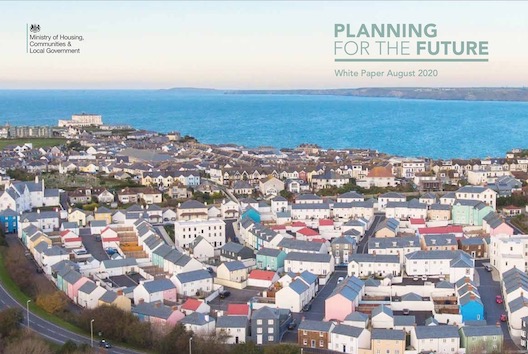Will French, co-founder of Ealing Matters and Chair of Save Ealing’s Centre, considers the implications of the Government’s recently published planning White Paper for Ealing.

There’s been much noise about the Government’s Planning White Paper, but it’s not an easy read, and even harder to know what it means for us in Ealing. This is what you need to know.
Two Headline Conclusions:
- This is no shovel ready document. For all the ballyhoo surrounding its publication it’s full of untested and aspirational rhetoric on a mind bogglingly complex area. There will be no policy or statutory change for some time. Huge work lies ahead in fleshing out the detail that will inevitably change the overall balance of the White Paper, but who knows how? The exception seems to be a consultation on raising thresholds for affordable housing to developments of 40 or 50 units. This could have a big impact for affordable housing provision in Ealing, and it’s likely to trigger a new wave of speculative developers zeroing in on medium-sized industrial units.
- The White Paper was probably not written with places like Ealing in mind. It looks targeted at middle England, in particular the shire counties that tend to resist developer led transformative developments much more firmly than Ealing. As we sit in a borough that has welcomed speculative developers with open arms for the past 10 years, this may look fair enough. But those same shire counties are the bedrock of the governing party and they won’t accept change easily. As policy develops, the risk is that the burden of policy relaxation will shift back to places like Ealing which already boasts it is ‘pro-development’.
What It Will Mean for Ealing
So just how the White Paper will impact on Ealing won’t be clear for a while. But we can pick out some broad areas now.
- Zonal Planning All of England, including Ealing, will be put into one of 3 land categories:
- Growth areas “suitable for substantial development” which would have ‘outline planning approval’. Ealing’s growth areas are likely to be the Opportunity Areas of Southall and Park Royal, both of which have already had massive planning consents granted on them.
- Renewal areas “suitable for development”. These are ‘existing built areas where smaller scale development is appropriate. It could include the gentle densification and infill of residential areas (or) development in town centres’. Most of Ealing looks like falling into this zone and there would be a ‘presumption in favour’ of developments of the kind specified in the local plan. National policies and guidance will help establish what would be permitted eg in terms of height and density. Government announcements suggest current standards are likely to be relaxed. Local authorities would be able to resist back garden development although Ealing doesn’t do this.
- Protected areas. These include Conservation Areas, the Green Belt, and back gardens. Perhaps also Metropolitan Open Land (MOL), designated in the London Plan. These areas would ‘justify more stringent development controls to ensure sustainability’ but again what would be allowed would be influenced by new Government policies not yet announced.
- Local Plans
Local Plans will have a strengthened role, not all that different from what they are supposed to do now – producing design guides and codes to provide certainty and reflect local character and preferences about the form and appearance of development. They should set clear rules rather than general policies for development. They would aim to give more certainty about what can be developed making the process for getting permission for development as simple as possible … oh, and provide local communities with a genuine opportunity to shape those decisions.
- Housing Targets
A standard method for setting housing requirements would distribute the national housebuilding target of 300,000 new homes annually. This would be based on, among other things:
- the size of existing urban settlements
- the relative affordability of places
- opportunities to better use existing brownfield land for housing.
Consultants Nathaniel Lichfield and Partners have published estimates that show Ealing’s new targets would be somewhat lower than in the New London Plan. This would be in sharp contrast to most other London Boroughs and Southern England generally, suggesting that Ealing’s present targets are much higher than they really should be.
- Decision Making
There’s much press speculation about how planning decisions will be taken in future, with a fear of a power grab by the centre. That may be the aim, but close reading of the White Paper shows the details remain vague and untested. The idea is that enhanced use of Local Plans – in which communities would be heavily engaged – and other ‘reforms’ will speed things up and reduce opportunities for local authorities to intervene. None of this is new. It formed broadly the last Labour Government’s planning agenda. But the complexities were underestimated then – not least in securing the buy-in of developers who lobbied heavily against local plan inflexibilities. There’s nothing I read saying it will be different now.
Councils may fret about a loss of influence. If this is because use of Local Plans introduces some clearer rules in places like Ealing, few tears will be shed except at events like MIPIM (the self-proclaimed ‘leading international property event’ hosted annually in Cannes) where the real decisions are taken these days behind closed doors. Anyway, when push comes to shove, national government will be very reluctant indeed to put itself in the firing line in defending a raft of unpopular decisions across the country. Far better to leave local councils to take the flak.
- A Single Infrastructure Levy to Replace CIL and S106 Payments
Community Infrastructure levy (CIL) and Section 106 payments are payments developers pay to help fund key infrastructure needed to support their new developments. Exactly how much these contributions are is decided by individual local authorities. The whole subject can be a source of confusion and behind the scenes negotiation between developers and local councils.
- A new levy would be set nationally and charged as a fixed proportion of the development value above a threshold.
- The levy should be used to fund affordable housing.
- Local authorities would be given freedom over how to spend the levy. They could borrow against it to forward fund infrastructure.
- The Levy could capture changes of use through permitted development rights.
- Government could also seek to use developer contributions to capture a greater proportion of the land value uplift that occurs through the grant of planning permission.
- Other Stuff
As I read it the five areas above will be most significant for Ealing. There’s much other stuff that needs noting but I can’t see much point in getting too worked up by it until we get more detail.
- Planning for beautiful and sustainable places. ‘We want to ensure that we have a system in place that enables the creation of beautiful places that will stand the test of time, protects and enhances our precious environment, and supports our efforts to combat climate change and bring greenhouse gas emissions to net-zero’. Yeah, yeah, yeah. And peace in the world.
- Culture change, better leadership and improved technology in planning departments. Bring it on.
- Use of design codes. This is likely to prove far easier said than done.
- More democracy at the plan making stage. Residents will no longer have to rely on planning notices attached to lamp posts to find out about developments.
- Enforcement powers and sanctions will be strengthened.
- The proposals should remove the risk of judicial review substantially.
Next Steps
As the White Paper says: ‘the detail of the proposals will need further development pending the outcome of this consultation. We will continue to develop the proposals as we gather feedback on them.’
Local Plan reform, changes to developer contributions and development management would require primary legislation followed by secondary legislation. This will take at least two years.
So new provisions for Local Plans are targeted for the end of the Parliament. Given the complexities, I think this may be optimistic.
Policy changes, including setting a new housing requirement, would be by updating the National Planning Policy Framework in line with the new legislation. So it looks like this will take time too.

